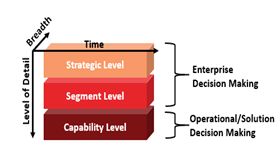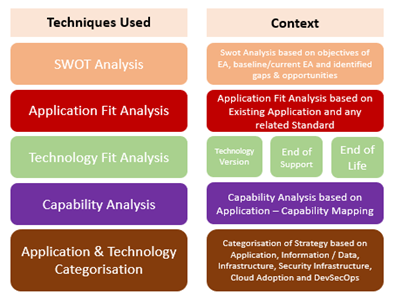Digital Strategy Development for EA Establishment
Figure 1: The EA Landscape

Developing a
Digital Strategy that aligns with organisation’s mandate
is done by prioritizing the business objectives against the strategic technology
investment. The developed Digital Strategy should consist of conceptualising
the IT landscape, Statements of principles and ways of working for digital
values through the establishment of Digital
Enterprise Architecture. The Digital Strategy will set the strategic direction to
create value for organisation’s stakeholders, define the required capabilities and identify the resources
needed to support organisation’s mandate.
The conceptualisation of the enterprise
landscape is done through the development of the Digital EA Map representing the level of granularity that
consists of strategic, segment and capability levels that each level addresses different stakeholders’ concerns.
Organisations should develop and map the Enterprise Capabilities which will
support the realisation of their Digital Strategy to achieve the desired
outcomes. From a business perspective, enterprise capability forms a model to
represent all the functional abilities an organisation needs to execute its
business model and fulfil its mandate.
From an IT perspective, enterprise
capability models provide a stable overarching view of what is important to key
stakeholders which will link business and IT initiatives together. Enterprise
Capabilities Map can also be used to map, validate and justify the existence of
technology portfolio as part of the IT landscape that has a direct business
impact towards realizing digital strategy.
Hence, the digital strategy development will focus
on the areas of innovation, investment, values and stakeholder’s satisfaction
as such mapping the motivations of key stakeholders in terms of their goals,
drivers, outcomes, requirements, principles, resources and capabilities. To
achieve this, the use of tools and techniques listed below
based on industry best practices should be leveraged to derive the digital
strategy.
Figure 2: Tools and Techniques to derive Digital Strategy

The following briefly describes the techniques used to derive the Digital Strategy:
a) SWOT Analysis – to analyse the strength, weaknesses, opportunities and threat in realising the organisation’s objectives.
b) Application Fit Analysis – to analyse and validate applications including integration service such as API and micro-service category against the business fits.
c) Technology Fit Analysis – to analyse and validate infrastructure components including system software, platforms, security and cloud categories against business fits as well as EOS (end of support) and EOL (end of life).
d) Capability Analysis – to map existing applications against the business capabilities and identify any redundancy, overlapping or duplication.
e) Application & Technology Categorisation – to categorise application and technology that includes but not limited to Information / Data, Infrastructure, Security Infrastructure, Cloud adoption, and DevSecOps.
EA Principles as the Fundamental Values
For an effective realisation of the strategy, there is a need to establish the EA principles as the fundamental values to guide enterprise decision-making process and act as the foundation for governance standards, and policy development in realising the Digital Strategy. The EA principles should be considered when making any decision regarding the use, selection, evolution and integration of all information systems’ resources and assets in an organisation. Each principle must highlight the rationale and implications in terms of resources, costs and activities or tasks.
The EA Development Methodology based on the selected framework will be used as ways of working in realising the Digital Strategy that covers the methods, rules and postulates used to structure, plan, and implement the process in establishing EA to ensure a consistent and systematic approach. The developed Digital Strategy should include the focus on organisation’s EA artefacts and all capabilities involved in a specific iteration. Requirement and change management are another important factor in implementing and establishing a culture through successful EA practices for sustainable digital values in an organisation.
Author: Aaron Tan Dani
President of Singapore Computer Society EA-Chapter [email protected]
Founder and Chairman of Iasa Asia Pacific [email protected]
Chief Architect of ATD Solution [email protected]
Related websites:
Join the EA activities in Singapore and learn how you can implement Digital-Business-driven EA in your organisation.
Computer Society EA-Chapter: http://www.scs.org.sg/Chapter/ea-homepage
Learn more about ITABoK (IT Architecture Body of Knowledge) skillsets and about the roles, scopes and impacts of EA Specializations.
IASA: www.iasaglobal.org
Acquire successful Digital Transformation adoption with ATD Enterprise Architecture consulting and training services.
ATD Solution: www.atdsolution.com